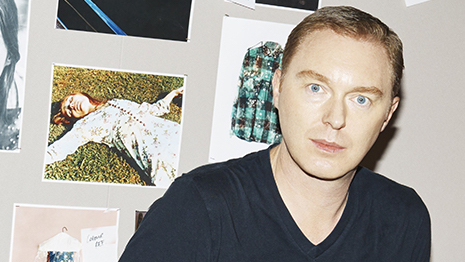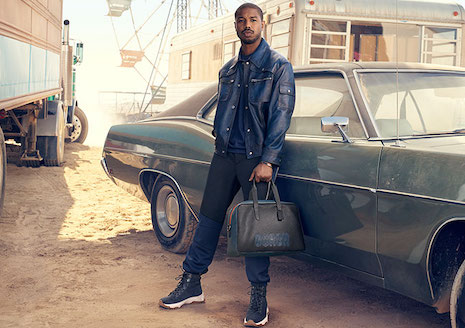NEW YORK – Embracing heritage, both from a brand and personal perspective, has helped executive creative director Stuart Vevers steer the iconic U.S. label Coach towards the future.
In a conversation between Dame Glenda Bailey, editor in chief at Harper's Bazaar, and Mr. Vevers at the Design Our Future conference on April 4, the pair discussed how their British upbringings have helped them succeed in the American fashion industry. Mr. Vevers has been at Coach since 2013, after stints at luxury labels including Calvin Klein, Mulberry and Loewe.
“I’ve always been very intrigued by brands that have an existing story,” Mr. Vevers said. “I think so much of a story comes from where you are and the environment you’re in.”
The Design Our Future conference was hosted by the United Kingdom’s Department for International Trade and the British Consulate General New York.
Environmental influences
Both Ms. Bailey and Mr. Vevers have humble British roots. Mr. Vevers was raised in Doncaster, a town in South Yorkshire, England.
Each also dealt with close family members who tried to discourage them from pursuing fashion in a professional capacity. Although Mr. Vevers’ father disapproved of him pursuing a degree in women's wear at the University of Westminster in London, his mother and aunt helped nurture his creativity starting in childhood.

Coach executive creative director Stuart Vevers. Image credit: Coach
Mr. Vevers’ professional career began in the 1990s at Calvin Klein in New York, before he climbed the luxury fashion ladder in Europe.
After working in the U.S., Italy, France and Spain, he has firsthand knowledge of how different settings influence a brand’s ethos.
“Environment has a big impact,” Mr. Vevers said.
For instance, he noted how Mulberry’s roots in rural Somerset, where the brand has a factory, are still reflected in its luxury goods.
Now in his mid-40s, Mr. Vevers straddles the edge between Generation X consumers and millennials. This gives him better insight into today’s younger affluents.
“I think people to do want to know a lot more detail [about products] and what the values of a company are,” Mr. Vevers said. “[Sustainability] is really important to me. The next generation is really demanding transparency and I think big businesses are going to have to sit up and listen.”
For instance, Coach does not source leather from Brazil because its large cattle population has greatly contributed to the country’s alarming deforestation rate.

Actor Michael B. Jordan for Coach. Image credit: Coach
“I’ve never used fur in any of my collections at Coach, but our customers were also asking [us not to],” Mr. Vevers added.
Tapestry, parent company of Coach, also recently adopted the United Nations’ Sustainable Development Goals, joining about 10,000 other companies including Kering, Burberry, L’Oreal and LVMH (see story).
Creative craftsmanship
Although Coach, which was founded in New York in 1941, does not have the centuries of history of other luxury houses where Mr. Vevers has spent has career, it still has a reputation for quality goods.
“Our clients often talk about handing down a piece to a daughter or son because our products are meant to last,” Mr. Vevers said.
Previously known as Coach, Inc., Tapestry has turned itself into the first New York-based luxury group by buying brands that are similarly positioned in the retail market but with differing aesthetics. Tapesty, which owns Coach, Kate Spade and Stuart Weitzman, prefers being recognized as the first New York-based house of luxury brands.
The chosen labels share an outlook of inclusivity while also focusing on craftsmanship (see story).
Mr. Vevers’ experiences in the U.S. have also helped him become more experimental. As Ms. Bailey joked, the British tend to embrace their “what will go wrong?” mentalities while their American counterparts have more “can do” attitudes.
Mr. Vevers thanked designer Marc Jacobs for exposing him to the value of creative collaborations during their time together at Louis Vuitton.
“Collaborations take you out of your comfort zone immediately, pushing boundaries and surprising people,” Mr. Vevers said.
{"ct":"haKTvASK1WddTTl0KOWzqOwfLY3IgSErnV5lF5bvtIIzNC1edtJvWForQHq4GQap0F+3LlK4+vUj6dVkaCmsRAhUPurmU7imsURNPR5qycjvHJeX1veg28jz5y4eEXUZHZRt2evCiqpCrN82bqdY+gWW0BKUPALFgirZfeMu3B6duC7PrntDTtEzMtWDgwsC0SepjmlQfGy0\/\/mxM7Nrk1XkaXlTRGlB0hoGsoyBtpYnsmFDl8co8toY6v2y+svM836QSO4ISsor9\/GW3URPcdoU3efOP7YI2krXsgAgXiXfm7O245A3LDaudg0LvxcE\/tdjlSUfNSuposKW7T3U5pfEfmiLJ3oWDW2AR+8kgRsFKC6p3UBrL\/XBKh3q8SGWepmLUQa6WTOy58GO5FMiZiib8AzuHq8Ctg34+XTX3mGfIdbfO7uRkQMfe4Q3QDcZe7XPj+dQu+RNHir5JvR7bLntYABrZmdnPCP\/rVXcX0WGBnBjLm13hkx47JSafOBMWyfDHHgMEEju\/IhUf4q8+8ky+waybey28uAXccH1d28XCXkWYDHQgW7o86Yu+fJtCM0mDAfBYNy6xxNwcfQHUfMm+rI5EVkhJapVXXjZw6VxN96WdMb5uQkoEuQABggbbDN8DMPZ8raCJwqE5nL\/oSvCcNTSPaIw7cMFnvX1KkPGRFlCxamgSBn0bcyyb2njjS+8g1DbZurB7bzth+jqYsNwziBqy5RkDWWLyp7AqhwMTKJEN9FmrAOyXRp1AIJBszjgkvnVLd4ioOcUQgVnubMR1pzeHpqN\/xHDB22GDBt6d2pGGDGHqsnxzn1KHDLQGcXUa9yP8K6NG2tHktVLtZqvImJZ4+6JlnCsPBWCcMYUpM8bMfREikSnk+AP8qsiZm9Wj0Jr+5\/Y2J5BCLqZgYP6l0C2ZXlyKN0GaWPzLaGVN84D5z7UOS8XpV9+KyhK1b4yhk\/H2Om8Jp4oZSmP4kMEtgWtlI8Jp1HTj2wk\/IEtRQ0JLdpwQEMjOa6wY7SdkyfwDxYtVE2t3rBrxNWdQKbNBiCeDgHwM+Hx1CRxGxiFPmf6BHJZ6WXR+udhnyedX+df00mzSYKdqYj90BaCPl0QcLEfyJTYOY6AVGqespfoj7cuPtQ4tsYctnhbLNPEUOQwKhbLhQ5MicAQawgAYv8HwdYlwPOoa3qzV+kXK3t07dKgdb3f5ksCgSpOou5YNe5y1W9C\/gKgYI0ctrd9Tx3bdrfsLLZNNIvwgc6ZBb53TJsrxrbg+bkJF5sAATc5SNf\/3V4b7PvsNHXud99wSjTY1rbk1\/cao8wH883h0BNTu7h8oDWgH4cqx2hdrgEJE3crqr3xxLHWwuQMJSUz7jbXffV9FiRoz1m6+\/dzRpDxlboB5ku5l87uS3Supetaft4qmZEZJePGglgMVt523RwtsSi5czJDr3+QT\/K\/zsKLFBZpOhSf58xCO0ah9dtBQ4n5EMwMC96MJ2xD2Me89wxU2EuyWUxCREqNhXaqSv+U0qCw63emPhiQqc+XcE7zdYqyJhKmFwelBFGpuZrO4+fXV1gmf1k7gIUBJURlzkadYTVkKl8omVzYIJQVrl1k9orcoRTqixSQ8Dm\/plzrwTo16fVzIctaht4wBOy3sJ0r\/Svx7xi7TRcF29fUa4Rc4KZsW7Nh\/wrU7l+L5jM3vXMJdLnCI90XTXSW9XORQ\/R6wLpU3Ko6cLSSq+Kg9bHGXTWojKzXqfkhs6eudQQBs2Kw+bDtm28ZA4yiHK\/kFzFPxSPyNM9Kx1W2V7nGdgGOe\/+o1D412R6g2oSYbF8Utje48CYkPe\/64b6zkgK6WDW6N8o\/QWNm3kMx33rZYug89m2tZQVG8OiCEHV9Acm0ZMlo\/jkvjk+aJJ2KdPpVxG5rbcCA4GYMxJkBh5Af2uGOIoDrurwZznnpd6+aphYJFGaBg0i8rM5X5IZsr3qgjMivz5jBfcou6xsgwZqxrmaohqadxikN3M6CRCV1ELl8vhNGV5PTyfdP4smgv7vplpgoSQcAGzJpgQJMsJOMRBNgkOUlS\/j0+ZD\/75A5\/XKK4ihdbFEHFphHidBUy2Oaq5a0Ir0Vjx86GirYGySaYeIvzjMQBZLB0UFN0mAyIMf37Kab1ldc0y04sNls+7KHYCGzuXqg6GOW4gxZfm+CMnFhbnS76H+msH0dVu5mKm+9TtjaAV6ong19w0LOc9yHOyqOUXNxxv7auqFrP8q34mBZUDzTu8U92oqOHmCMMZask+hsXTx2Y4Y\/0aplB8c4mJLzcUnslTVeWm8hPE92QWEfO975VNeGhA6vNsHxq4Uk7iF72OvYmaGTkcuDjDHz9fPlmzSbzzLGNWMpf+StgcF5gYhLA50CR+7D89pyLvz0klAxbA10u2\/rcd7tYK6VR26Nk8VZ3KMpfuL8lsws2hwj6NLjE5VLiz8Im4eR7CwEGPM4srWgsP6khiHVsc+vjKw70uDOoqWXrIf8pjGz3w6VELKSOrpbefVInhQf20cGg\/4dQsdZCgG4UtxQ2Co3cfN\/AVsn2r8laSDn8hIqAk3BkFyoFgHHaYyQ92meJM\/ubtAXZ\/MOyPNWRk3VpZvP2CGJfktoWjd57rozJw00tDbX4ml9IYneULHGQ6o8O2+0cDdnZA\/x\/HHPdWJDogiZ3\/HvPnkUErg2h+ck0N3sjwe1WU0p6aOJJiWftHpW7oypCdT1j7CRSVJKsyBfBYdCuwlDnnIzhOIHbZkAFePAyg\/Nd0MiPeI8wWWMOSCL24KS1BZJpo4MkGI35Jj\/1aSF81WPwQPHSF4+J63mZ9gCQ0A0Teg73E62nn47MSKmHKT2+L1ciWlq8fEVi8T4Qs0PuIDHIxqVBh\/dmyKIbMOJDxjrLK+990M3d9GSYnHXoGNgPXUpR23VQv1dDQ0UtOBWz83ttN5OkbEL3fePH7wWtXTNL8FSYX2fY5ZgjwYG+uY3gPKtOsmos8VKN4w+9ai1+XPa\/rONrXQJX+WnIyf13jc+oQ2F1EwmJNcG7\/no6B+MtXGbpXhdP+EL1hXNeT1Q8aV2N59MSgW3Hmkp7i9mKuTy\/LIWirum+NK76BM8BihmFuwO\/mZ0tvg+j\/2B8GU3whbXaMtHy+KTLmnpokfomHFhnKUEId3xmr2sxM7lXyuhhzLfP+CCOWezBHB9CbmWc4Ry\/AqxLxH66QSRQ47Ml6Lwu3erOYiDc2hlcCFPCxKU9Xxs+ny+qRN+22+ozFabwM1aIbmJHfkOqTCZKn5B8i5YVMfT8Wz7XATASkCDON78Vo+Cvb2BqOrq+YK7fqAhXze017kMjVuIdSI2eot\/u8qmXq\/WhUsgwMzgZPswwIY9ixg\/8l7gQHt\/yBQ1kouBvhVFI+Xy6Qiv6jMZqUk1zb7ZwHSLbIOuSLdLfWf2aKL5WuE6GnIaAL1wfrMDKFNh3YZX2Ov07ivJJ6Fff9xoqsWFozQTyON9kwhj8OQ2u9EZ4kmqL5zvYettHcy1RHkn00QvbzmmDQciKGunHSvJKTTUZLBULG0c9T7DUh9EoayRv8\/Yc12GbEdcacLCG\/ar68nkkFzxF5yAFH5dYMskglw76+yEVijYPvlwd9XRFBDAcp14UdQE\/qnVO0NbOiN6dYn0RD\/nC\/qNkC8qMSlVN3pf0A9Ir9dtl1UQnyOFUkB98U7Dh4Tvzq4fZvO55nPjj\/8KzJKjzJ5Qh3a7l9cdkZnelMPxPGhmJNVZ8WPG3rbkiHYuE4rkZnfGL4k8aHPjNsJqOesK9qAGOK7+Gy6gP2NsH30WyDC25lsULx+lkQ\/VjqXz4E6eJc+hZrR2IYv6zfY1J1lFung7yOstpz1TEdm+w2z1hkeNO7GYo9ixXb0c6zbxyGIvSzFtkpm7EGZjIstHLH0BiZNEBAbGq6GN6G+twlJIOqCN6nE8ZTviarVhJzChGw7B2nVocBteKauHGHXfIYiRpKgtBaIHJhoOucWLbiPs9yHu3fO5QjgizxWtzdGlFDABNXr+62dwhk0R73H2T1\/TxRWDORxYvhyBDzjApZTtCvi0w\/2yH+RRpisA+A1muSpRYDd8\/\/dPK9hY6dYhrygv5QELYjp1PgOlUstCl3lqn\/NXLtRlOeXnS+rnZPpz1+MhL9alqsE\/BAyexKbUrcEsRl9QhDYFq1WVnZzpV2T1BivKW4d6eZV6RePKRZIz1GFoSkQ7eXLLhXamDCFhsoZEfA6QdSx3YoAdQaZ1FigbHfOmXtW2lOtGhXNyDCJS5Pe1XZiMCFmnHStjdEMcsgZV56IV+djp5lNDqJbaIoCxzteul6O5TPoiqv2mnL3zS+CRi13LM0aKhk7BGc+1qGnulR3uqTWU5Lg6jzCrOZ\/xiIaJVD6cVJlp2\/Mbe3g7yvog6+042tL6nScsXQZvxl11CkOiWCAFJBetAGTdyF2SSifx7dgP3VTQj5PRZASNuuOTQIywM04vtVcJpH49OS3DJNjSZhrBZsPxGRrViOMvt7oQkkR2m+bV6ZVhEGTd6KZMFaItSQAdegFY17\/wBMS8wtH8LO18Zv6h5xGmbPm8CW0EO90fp+b128A6dodvMGSIwMqxZa5UjcYquf9\/gCGth2nvCD3Sb0SD5w+Si5bLrGnOhvdANubegnsHgxMretsuTKUQGXsrbyij1j81L+MTWO\/Au3JhmF5ansAdycer9fTDBiKk8ecHCSrZeLO3FfAL5XuhghoEz3kD\/8xjEUNJYA51IsZ0dxZbUtXydJ4jUal4iZFGpY\/WagMxUW100KF7cIc5XZXXFFxDlSWd9R3\/80gGmBiD+FBzzAYsn0s+DyVoTwb2Y3VZB8V0tFho52E7WtoQGTmb4N3zZe2waffbjkK1z40GigtJ4JhuVki3pLwx62oJEWAztHWS3sx+05lwNuf5MVy8Zwyxo16Hw+sZ0uq9woQXGqQ+AIKyw0pqjvBEXgz\/Hq3da2vO15nN2KrtJYqpvYOAX5t0u7KiI5x4PVkWhS\/f+QZqCyOvTDu2ORK5pW9pWr8rrKPCcPp8sFJKtA5XywtpqRqnAz7Nr\/KNu\/dyzitefcsUCmZ6Kb3hjJ9K6R9v+WmPjyTQh38wkYVqekYmwuJHXCLGg4Gst2+A2OOm+xMsPxI7TY5vwYy63YzsMXhbMH12+LE6BNmyrUT7+nKBGdVBGHVdz3xcnz\/S8MvoBvwHzbYOk4gXHRiWTLf1\/cfR0bzlEdFTP7U4OG3pue8DhVJKoWkqTzxGPyYOHNsHw5KEbttk3wG3tvSOEYPxBsZC47sKcVmyITXtds8sWPlZjWrrnTHtUPQnzdxHWHWfBCYFZd6TNzVIhnDAIcIaGVAhepzx8loT0ykUeMlOfblfLqvemoG9JJVTN5pBuq3dgXFg9g2sZ+\/riuvX6GCX3LAUsLcemCBnxTLw3P5uBzRpimuAfny+3E9so+w2n+5IN2Ke3m+Dv3vL5BnE4xPrRjH6OK7J2zeY4kFWMXTZe6d0M\/jQor4vgxXm9VBcvOmxMGSICt3jb1a\/e2KBKQNlqLXC\/9EPqDQqz4bkuMCLehXcity8hkRKQV4WC40LBWNCyZxa0ro+bVovXcRyE7eA0p\/zPFPO1t445mVXLN7Rco4\/UZl1HszwIcHMrO8Du49AgbyOQZFRwXI0YhuA7K0WBTfP7PKRjQBOsbZH9+7YrvBup4QBoNBHDgbNsGXUR+8xDympvqLM6UAjQfvxhMAzo+BbiBys6QRo2w8nV2Oj9Qr52JbI2gT1p20NCoB24KJtvpCZ71ybAityKwPLL+4AXWTang7EcLkVBkRb3j5f3VNFciKlY4cxynl6\/97zlCETTFOuxGEeyOew3AePuKDN6j\/w0Q4EWpl0BEouU+jRR7YadOHjD1Kn6\/ITHvnF21rjK1NSmP9+b13R4Q3+KiNASUiFw+TCsQbySIrWwKg97V5v7rjgMayOVFNuj85gaFZtRqJ9u5an2eyl2wzifhgsiEyq1Mo0ILPYnHhq9+EzFgdEZ2Brfydvqwhyk8RTSW82X8ggU5CRpe1Ja+6ipkqxfrYD3Sw\/Cm6n+QmGdAP3A7o1eRigEHdr\/kCNAr2JOylYbog+\/u\/yGG5H9x8ZR8VGe2glWheMhT5yg18hPpsE2LX6wafPk\/0Fl4ZmkQnrXVJZ2ixcGT748RQqIRTIUMLNVbeF+bj8w47ThSAcsBJbT68tqVu5MNJWMWp5JCgJDckR34omaEDZXKOOBq0HLCZlJaQdijWqjk3WfjxEYMqqdGdm1KkJsfti15+t3sMr3R8Msj+UWkMYmNHHz7WbJe2zdpqItkm8LzpkhrLsHRxmAX4Y4n8Iz\/2\/NGsL9qbUrK67QNdpTmKE4lgKaAW79Ox1FbRK+WVyhk5Q5kEf8B\/LUAHWO+nLoPEu9RZdDoZ+wdD9HrrG3788whCP\/B4gHpIXM8vJFqCVq9I\/Pu3NJuLLUL1\/W3mNX97O3TvY3ZFoAU4R2D\/B3aBLSZSDbWz92mXmGrvrRwz4BjdQjfRC6nMRkTm2jnr\/AHRp6Df4ubUzcQNrlVY0W6RPG6otcXCMChqmzgpeRMDzv5rJmtwwB6YOSpjLGIL7J0PqEaw7lL1MMXnRljQXxccFoIySRFgiEgZPt3v9grB1NUdxk\/\/jVQIDUKQv880E6xsXjNw2\/Xrg9YQV1RPyEoqRhUjJEuKDsxlxF1UFwNhjXMOZ2HI+Tj+YGJV\/n8\/l6J4zMrvnlG4HlPiGsEGRtWs8XQbWODXZR0jUJ0qKklzUHArw9hYfSn06MPtfBtXLZhK\/19fhw+ainBlX0zIRlNIETz6IJBp+ssAefANP7fizSqHgaFKmjiU2yINM5g65s4h4tO4QuQ5D2z\/QY6kcItB9lt+Gxl+Klaf6s2+DLpaAB2xLbiKyhANZ3g3swSn0p2OTMuEKdrIhmL0iX23xwIBK4Q4mntGNF0HdIFAkr7iH+STr\/Ch6goE9BhbbVXb2B13SOjsGcE7sRUdDMxn5IfnPJWCKfzIxfxp0yDggUf4fvCYPebBb4MXchoYWEnpkSFZkfUjW4+mnet6L0P9vggtRzwHBmnP1ru03w0Aocj6aLrgPqOlXEohBuEIdNsXxyh4uTeLm3ju2JixXqyjl+xorkJE1RV0X\/oJ2kne6apTPRrlVzFcbRpzfQARj67wwStnjOleWZDM8ygUpV9PwiZ9vl03nT5ybWfJG2on50QaJrgkKFN\/EdQfX6k8Y0RVrPLrAkg\/nR1R20MWzpve6GVX0B+pASax+YwdmlQwILcYYSXyn1b4e9ZwqpcpcfAPHmWNKKxSQle4SMT9vvG5qwhQ\/Na1zXTtc2l1AI47eOFjaP8bp+A0UUEpEk7hX7UrNg8SE7FuWuRY9HEI7FdQriNcVpCRkl+85HCFmIN4Xdrz8btI7MDoGcCrJMzTY4OLhS0R0cCR25251r3c9XBEZhTrJq65aXJsznR6csG6bZFFtNr4tEnGbAUTm3QgXJuE8+yEJXli9ZE2go3vSxX5AKbnc5DQlln\/sCQLsqvBPtqFh8WpVbPVEHy2YZbPZbza\/54pisItqS+b\/DFYc1zVFhtsvU1gD","iv":"63715c54ef62a6a4df4c9e45c97ab588","s":"9854701efc204639"}

 Coach is led by creative director Stuart Vevers. Image credit: Coach
Coach is led by creative director Stuart Vevers. Image credit: Coach